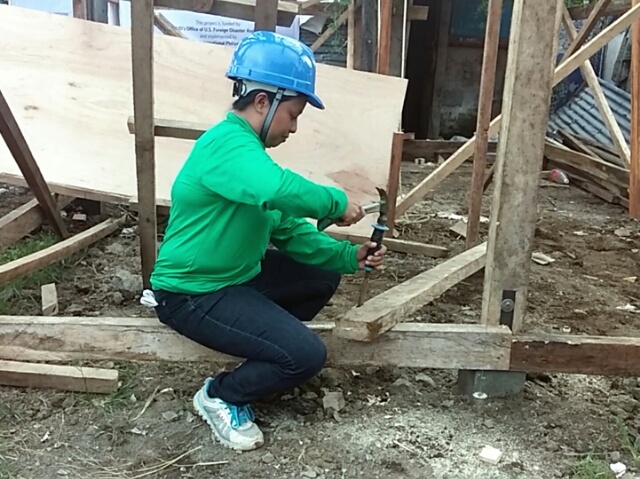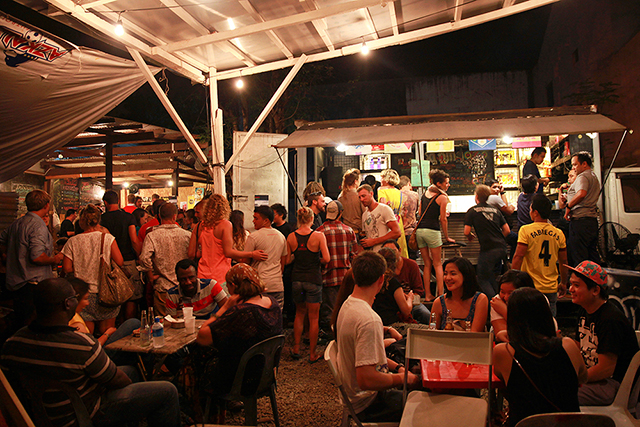ADVERTISEMENT
Filtered By: Topstories
News
First Person: Rebuilding Tacloban City after Yolanda
By AMILLAH S. RODIL

A Yolanda survivor building a house in Tacloban City. Rose-An Jessica Dioquino
When I saw the devastating images on television in the wake of super typhoon Yolanda, I wanted to go and help as soon as I could. I got my chance when I got a call from a United Nations agency as a consultant for Tacloban City. As an urban planner and architect, my job was to help facilitate the formulation of the recovery plan of the city government, along with the city planning team and other consultants.
I say "facilitate" because we were not there to dictate to the city what to do; this was their plan and we were just there to assist them. I accepted the job because I wanted to be a part of the process of rebuilding the city; I believed that this was a great opportunity to push for change, and raise the profile of urban planning.
Upon arriving in Tacloban in late January, I jumped straight into preparations for a workshop with various stakeholders to discuss the physical framework for where and how Tacloban should rebuild.
Through this workshop and further discussion, the following strategies emerged: the downtown and airport would be kept as is but built to be more resilient; mid-Tacloban (peripheral area north of downtown) would be an urban expansion area, trading center and government center extension; and the north of Tacloban (where existing government land was located with low risk from storm surge) would house the new township containing settlement areas for those who were affected.
The plan, however, was not just about the physical rebuilding and eventual future development of Tacloban. It was also about the recovery of other aspects of the city, such as shelter (over 50,000 houses damaged), social services and facilities (seven hospitals and 17 public health facilities, 90 percent of schools, and 36 city-owned buildings damaged); infrastructure and utilities (water was restored a few weeks after but in March power and telecommunications such as internet and cable services were still not fully restored); and economy (at least a hundred businesses had filed for closure; in April only 20 percent had renewed licenses).
One of the major challenges of doing the plan was the sheer scope of work in such a short amount of time. The planning process was envisioned to be as inclusive as possible, involving many stakeholders. This meant a lot of coordination and consultation had to be done in time for the Mayor's target to launch the plan in March and eventually present it to the national government.
There were also lot of actors involved in recovery: the city government, the national agencies, the local and international NGOs that had come to provide assistance, the private sector, and the affected communities, all moving with their own objectives and timeframe. The efforts of all these actors needed to be mapped out and coordinated — and situated within the overall recovery vision for the city.
The very nature of planning demands, or assumes, that there is time to plan first before doing anything. But in this case it was difficult to ask people to stop what they were doing especially if there are no alternatives presented. For example, in the 40-meter no-build zone declared by the national government, many people had already rebuilt, using whatever materials they could find.
It is possible to stop rebuilding temporarily, such as in the case of Japan. I had been to some areas affected by the 2010 tsunami almost a year after, and the affected areas were still empty, razed by buldozers - waiting for plans to be finalized.
Obviously, reconfiguring a devastated city could get more difficult if you just let people do what they want, but there is also a tradeoff in delaying action -- it also delays the recovery of the normal life of people. So in Tacloban, we had to plan while doing - with the plan serving more as an initial framework or draft with the details to be filled in or revised along the way.
Since I came here there has been steady improvement. When I moved in to the apartment I rented in February, we were still relying on a generator that had to be turned off by 9 p.m. By March we had power; by then, about 82 percent of connections had been energized.
Back in February eating meant a round-robin choice of about three to four good restaurants. Now, there are a lot more choices. A surge of businesses reopened by the third quarter of the year due to soft loans offered by the Department of Trade and Industry. Robinsons Malls fully reopened in June, offering movies people missed at discounted prices. My apartment's cable services also went back up in June.

A local pop-up bar in downtown Tacloban City. Reuters/Thin Lei Win
The influx of assisting organizations has also brought with it a new, albeit temporary, economy. The big organizations have blocked out rooms in hotels, or rented houses and buildings for their staff accommodation and offices. Vehicle rentals have flourished. Restaurants and eating places have had good business from transient workers.
One year after Yolanda, many parts of Tacloban look almost normal. Late afternoon in the downtown you will find typical city scenes: students filing out of school, office workers rushing to get jeepneys, groups of friends lingering in coffee shops, fitness buffs jogging in the public track oval. There is even some traffic (and traffic lights).
But Tacloban is not really normal, not yet. Amidst the images of a bustling city, there is still uncertainty and suffering. As of October 3, about 300 families were still in tents, and 3,600 in makeshift homes, the term used for those who have hastily rebuilt wherever they could. These people remain at risk, living in poor shelters in cramped conditions, facing the phase out of relief. Those in tents are targeted to be transferred to transit houses made out amakan and nipa soon, before they are transferred to permanent homes.
As for permanent housing, based on figures from the National Housing Agency, there is a total of 13,187 houses planned for Tacloban in various stages. Including NHA and LGU projects, these comprise 85 percent of the target of 14,433 units, based on the number of those in high risk areas. Fully-completed houses are 68, partially completed 1,107. By November they aim to turn over about 800.
The common question that is asked for the recovery of Tacloban is, why does it seem so slow? Like a person who gets sick, the recovery of a city depends much on its health and how it functioned before the typhoon. Stronger, more resilient parts might be able to recover faster, such as downtown Tacloban, which, even though it was flooded and looted, remained mostly intact. Vulnerable parts of the city, such as informal coastal settlements, will take some time and may need a reimagined future. The creation of new parts of the city, such as new settlements, will take even longer - mainly because it needs to start from scratch, and needs more than just housing to work.
I came to Tacloban wanting to push for change. I discovered that it wasn't easy. There is a multitude of elements that are needed for recovery, and the city government or even the national government cannot control all these. I ended up downsizing my expectations. Tacloban is indeed on the road to recovery -- but whether it will be a better and more resilient city - is something not yet seen, but hoped for. — JST, GMA News
Amillah S. Rodil is an architect and urban planner hailing from Iligan City, Mindanao. Her contract in Tacloban ended last July, but she decided to stay to volunteer for the City Housing Office. As of this writing, she is walking for climate justice with Climate Walk.
More Videos
Most Popular




